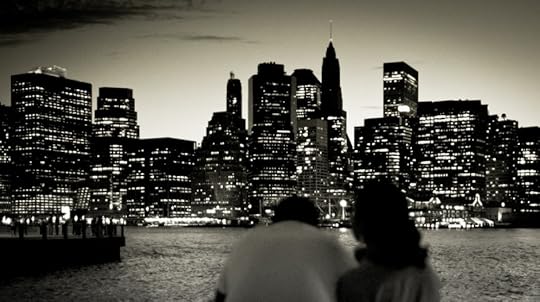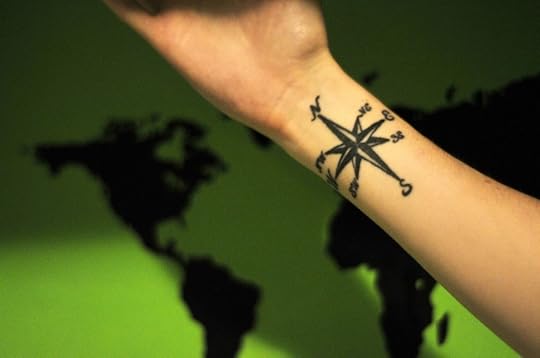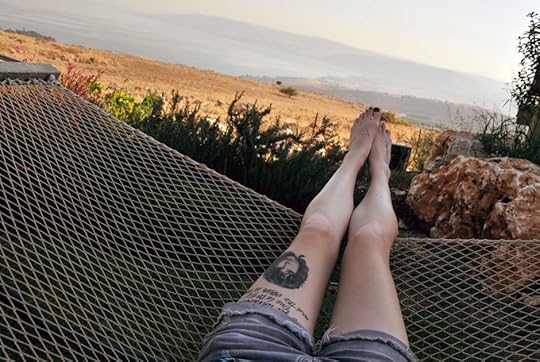Matador Network's Blog, page 2229
August 12, 2014
20 signs you're truly Scottish

Photo: Hamish Irvine
1. You know Irn-Bru is the ultimate hangover cure.
That fluorescent orange glow. The tangy, sickly sweet taste. There’s a reason Scotland is the only country in the world that sells more Irn-Bru than Coca-Cola, and it’s because we know about its magical headache removing properties. If only it would take away the cringe-y memories too.
2. You know what a ceilidh is and how to pronounce it.
And understand exactly what’s being asked of you when you’re summoned to do the Gay Gordons or Strip the Willow…mainly because of the endless years of torture and humiliation you faced in primary school learning those moves.
3. You expect free prescription drugs and university degrees.
You think it’s crazy how much people have to pay for them in other countries. It’s your right to free healthcare, so you can’t imagine living in a country where such a basic human right is denied. Nevertheless, you could spend hours moaning about the NHS.
4. You know how to pronounce Edinburgh.
It can be either Edin-burra or Edin-bra (or, if said quickly / intoxicated, Embra or Enbra). It is never Edinborrow or Edinbuurg.
5. You’re either an Edinburgh person or a Glasgow person.
This can range from a little lighthearted jesting and fun-poking at the opposing city, to a full-on ranting rage about the other’s obvious flaws.
6. You’re mentally prepared for rain at all times.
You know fine well that just because the sun is blazing this morning, it doesn’t rule out a thunderstorm in three hours’ time. However, you gave up on umbrellas a long time ago and now just grumpily succumb to the skies.
7. You know that as soon as the sun comes out men will take their tops off.
It may only be 19°C outside, but every summer as soon as the skies clear, men of all ages throughout the country will be stripping off their t-shirts in gardens, towns, and parks, baring hairy chests for all to see.

More like this: 14 signs you were born and raised in Glasgow
8. Your people are obsessed with the weather.
The weather is the ultimate conversation starter for all awkward situations. Any time you meet someone new, the weather will be discussed first — especially if you’re talking to a cab driver, a stranger at a bus station, or anyone working on a checkout.
9. You let tourists believe all the legends are true.
Sure, Greyfriars Bobby totally happened. What a heroic little dog. Haggis? Yup that’s a small creature running ’round the Highlands. Oh yeah, I’ve definitely seen the Loch Ness Monster.
10. You smile and nod when tourists tell you about their Scottish roots.
You understand they’re telling you out of pride, and you honestly do appreciate the sentiment, but you’ve heard it so many times now you’re not really paying attention anymore.
11. You suppress your annoyance when people judge your accent.
Whether it’s, “Sorry, I have no idea what you’re saying. Speak English please,” or, “Why don’t you sound Scottish?!” both are equally annoying.
12. You’ll support any football team that plays against the English.
This is done with just as much passion as if Scotland were actually playing. But you know really it’s just a fun, long-standing tradition and doesn’t mean you actually hate the English. I mean, we need something to be excited about — Scotland rarely goes far in international football events.
13. You know Scottish pounds are legal tender.
And feel rightfully disgusted whenever you’re in a shop in England and are subjected to having your money scrutinised by the cashier for five minutes before they finally accept it.
14. No one’s tap water can begin to compare.
Except Switzerland’s, but we’ll just pretend that’s not true and happily gulp ours down anyway.
15. Planned BBQs will rarely work out, but you still try.
These failed attempts often result in a makeshift BBQ in the kitchen, trying to drown your sorrows in *insert alcohol of choice here* while torrential rain floods the patio.
16. Men dressed in kilts don’t seem weird.
It’s the standard dress code for all formal events including prom, graduation balls, and weddings. It’s also totally fine to be a True Scotsman and forgo any underwear, usually resulting in much hilarity and some interesting up-the-kilt shots once everyone is drunk enough to happily flash.
17. You know how insulting terms like “scabby,” “scaffy,” “jakey,” and “minger” are.
All are words that get thrown around the playground on a daily basis to insult and demean your fellow students by essentially calling them ugly thieves. You also know that one of the greatest comebacks to any of these statements is “Yer Maw.”
18. Chips and cheese are a drunken ritual.
For some inexplicable reason, you’ll need vast quantities of grease the moment you step out of a nightclub. Luckily, there will be many a chippie waiting to cater to your drunken needs. If you can’t get chips and cheese, a kebab will probably do the job.
19. You add an S to the end of supermarkets.
For no logical reason, Asda is Asda’s and Tesco is Tesco’s.
20. You don’t want to talk about the Independence debate.
Like most people in the country you have an opinion, either for or against, but it’s got to the stage where you just want it all to be over so you never have to listen to another drunken screaming match in the pub ever again. 

On life as a pro climber
Editor’s note: Matador Ambassador Katie Lambert, along with her climbing partner and husband Ben Ditto, have spent the last several decades traveling for new climbing objectives. Last year they were part of a team that climbed Mt. Proboscis in a single day, only the second group to achieve this since 1963. The pair also explored some of the world’s best limestone in Catalonia, Spain.
After she sustained an injury and took some time off this past winter, I asked Katie to put together some thoughts on her life as professional climber. 

1
Getting to know the locals
I have a hazy memory of standing in front of the TV flipping the channels and stopping on ABC’s Wide World of Sports. This was In the back living room of the mid-century house I grew up in, during the heat of the southern Louisiana summer. Two men were on the very tip of some skinny spire, the ground dropped below them hundreds of feet away. I stood there in awe at what I later came to learn was Ron Kauk and Jerry Moffat making a rare free-climbing ascent of Lost Arrow Tip in Yosemite. I recall wondering what they were doing and imagining if I could do that, too.
Photo by Ben Ditto

2
On my home turf: Peace, 5.13d, Tuolumne Meadows
I think that’s where it all started. A tiny seed of an idea was planted and no matter how far fetched it seemed and how far away I lived from the rocks, I was destined to follow that seed. In my mid-30s, when I arrived at the threshold of being a professional climber, my first instinct was to run into that world without looking back. However, after spending years around some of the first professional climbers in the industry, I had gained some insight into the game and one question kept coming to mind: “Could I maintain my integrity, my soul, my story, but also be a good rep for the business?” I said yes to some opportunities that seemed in line with my ideals and no to the ones that felt like they would pull me in the wrong direction.
Photo by Jim Thornberg

3
The world within worlds
Something I have learned from climbing is that by spending time in nature one becomes more aware of other life—the worlds within worlds. We are all connected by at least one common thing—striving to survive but enjoying the time in between. It’s interesting that as humans we have the capacity to create how we will survive. The mind is a powerful thing. The imagination creates and the body enacts and between the two is the self and the spirit. Being a pro climber means that I get to practice my craft, perfect my movement, refine my technique. It allows me the opportunity to fine-tune my body and my movement as well as my mind.
Photo by Ben Ditto

4
#Vanlife
I’ve been fortunate in my climbing to experience faraway places, world-class destinations, dream climbs, amazing partners, and a lot of inspiration from both people and place. We travel much of the year and so it feels like life is in flux. Constantly on the move—to the next adventure, the next objective. So, there is no real solid definition of a home to settle into—save our camper van. Our sense of belonging to a place is fleeting despite spending large amounts of time in the Sierra Nevada. Every place we travel becomes our home. We have become 21st-century nomads on a landscape perpetuated not by the need to survive but by the desire to rock climb.
Photo by Ben Ditto

5
So tired
There have been so many places, so many moments—it’s only in looking at photographs that I can bring back the memories. Otherwise it’s as if it were another life.
The idea of returning to place comes back time and time again. Through all of my years of flux I realize that the connections to place are deeper than a home to rest one’s head. The connection to place runs deep in our psyche—the relationships we have with the rocks, the landscapes, the people we meet along the way, and the experiences that build in us—these return us to “place” and help guide and center our lives. These are intimate and give us a connection to something concrete and tangible despite being ephemeral.
Photo by Ben Ditto

August 11, 2014
14 signs you’re married to a German

Photo: Chris Zielecki
1. You’ve had the Speedo conversation.
Even the hairiest German men with the worst sunburns and the biggest beer bellies love their teeny-tiny Speedos. They wear them at the beach, with shoes and socks at the resorts, and, if they’re feeling fancy, with t-shirts while lounging at the pool. Some Germans can be convinced to don more modest beachwear. But for most, there’s no convincing them that less is not more. Marriage is all about compromise.
2. You know real beer can never be lime or chocolate flavored, or worst of all, “lite.”
For Germans, beer is water, barley, hops, and yeast. No tinkering allowed.
3. 4pm kaffe und kuchen time is sacred.
It doesn’t matter what else is going on — everything is put on pause for the traditional coffee-and-cake break in the late afternoon. At this time, you’re reminded of exactly why you married a German: nationwide permission to have dessert before dinner.
4. You’ve stopped defending the bread from your own country.
Germans take their bread very seriously. It’s dark and crusty and robust. Never white and fluffy and sweet. What Americans call bread is an abomination to them.
5. Sauerkraut is in heavy rotation in your household.
You can no longer imagine serving pork without it. And for those days when your digestive system is a little…let’s say, plugged up, you know from your mother-in-law that sauerkraut is the cure for all stomach ailments.
6. You know what the “Klinscam” is.
Even though Jurgen Klinsman is now the coach of the US national soccer team, the Germans can’t stop obsessing about him. He’s a soccer hero back home, and beloved for his expressiveness on the sidelines as a coach, especially compared with the current, stoic German coach. Watching Klinsman’s reactions broadcast from a camera permanently pointed at him (the “Klinscam”) during games has become a popular spectator sport.

More like this: 12 signs you're married to an Irishman
7. You’ve realized how weird it is that the fast-food chain Wienerschnitzel serves hot dogs.
First, you learned what a Schnitzel really is. In the next stage of your indoctrination into German culture, you learned the critical differences between a Jager Schnitzel and a Zigeuner Schnitzel. Now when you talk about the nation’s favorite dish, you know it’s important to be spot on with the details.
8. You’ve learned to interpret lukewarm responses.
You know that German men are, shall we say, a bit muted when it comes to expressing their feelings. Whatever their reaction is, you learn to crank it up a few notches in your interpretation. “It could be better.” = “It’s great! I love it!”
9. You no longer say things like, “Let’s do lunch sometime.”
You’ve learned that Germans can’t stand the American habit of flippantly suggesting get-togethers they never intend to follow through with. What we Americans consider friendly small talk, Germans find a waste of time.
10. You know lederhosen is about as representative of Germany as the cowboy hat is of the United States.
Your German family has schooled you on the fact that those cute leather shorts you imagined your husband wearing as a young boy are actually Bavarian, and not typical elsewhere in the country. Which is disappointing, because they are really adorable.
11. You know that on December 6, Santa Claus will come beat you with a stick.
On this day, Germans celebrate Sankt Nikolaus Day. According to folklore, good kids get their stockings filled. Bad kids get a bag of ashes and a beating from good old Saint Nick. Well, at least you can recover with a mug of gluwein. Once you marry a German, the holiday season will never be the same again.
12. You correct people when they describe Arnold Schwarzenegger’s accent as German.
Thanks to your German family, you can now tell the difference between Austrian and German accents. Or at least, you pretend that you can tell, and you agree with them that Austrians talk funny.
13. Dinner at 6pm means 6pm sharp. Not 6:10 or 6:20 or whenever the roast is ready.
Germans are known for their punctuality. Through trial and error, you’ve learned that getting dinner ready doesn’t mean sipping a glass of wine while you casually cook and chat. You prepare your dishes with a chef’s precision, making sure everything is piping hot on the table at 6pm sharp.
14. If you rooted for another team during the World Cup, you’re still hearing about it.

SharkCam vs. great white
Shark Week is upon us, and that means insane new footage of sharks doing terrifying things.
This year’s coolest development — aside from Sharknado 2 — is the REMUS SharkCam, set up by the Woods Hole Oceanographic Institute. The SharkCam is actually six cameras mounted on what they call an “underwater vehicle” but which looks more like a steel torpedo.
The tech was designed to capture sharks in their native habitat, but it did a little more than that: It caught footage of a shark attacking it. The strikes, which come suddenly and out of nowhere, are heart-stopping, but they can’t help but leave you impressed with the speed and strength of these amazing predators. 

24 hours in Fremont, Seattle

Photo: Lambert Rellosa
Here’s what any honest Seattle resident will tell you: Skip Pike Place. In the time it takes you to weave through zombie crowds waiting for flying fish, you could be rambling through the neighborhood that claims a seven-ton statue of Lenin, houseboats that aren’t famous, and a chocolate factory (whose all-you-can-eat samples trump fresh produce any day).
With naked festivals and plenty of happy hours to fuel the hunt for oddities, Fremont neighborhood (two miles due north of the Space Needle) is a holiday away from your Seattle holiday.
Morning
Ignore Pike Place by hopping on the #26 or #28 bus from downtown. You’ve arrived just after passing the sign for Center of the Universe, proudly posted on Fremont’s very own drawbridge.
Start the day by observing the golden rule of Seattle coffee: Don’t drink Starbucks. Go local. Fremont Coffee Company will show you why we’re such proud coffee snobs. Take your beverage for a walk on the Lake Washington canal, where Googlers seeking respite from algorithms lounge alongside dog walkers and tired cyclists. Relax on a waterside bench and stare at houseboats and sailboats you can’t afford. Wonder if you know anyone who can.
Or just go shopping. Vintage stores Gold Dogs and Atlas Clothing, a megalopolis of pre-loved garments, will help you add flare to the same travel outfit you’ve been wearing for days. For free fun, Jive Time Records and Ophelia’s Books are antidotes to the digitally saturated world, offering dollar finds and unrushed attitudes.
Lunch
By noon your stomach will have noticed you can’t go hungry in Fremont. Seattleites know pho makes any ailment better, from hangovers to breakups. We always have a pho recommendation. The fragrant Vietnamese pho at Lucky’s satisfies for under $7.
For the gluten averse, the treats at Flying Apron Bakery make even gluten-loving customers nod in approval. Norm’s Eatery and Ale House serves up burgers and beers with a dog-friendly policy. Everything tastes better while watching puppies play.
The only thing separating you from America’s Greatest Pork Sandwich is a thigh-busting climb up the Fremont Street hill. Paseo is Seattle’s least best-kept secret. Make sure you’ve got cash and patience to stand in the inevitable line. The reward is a Cuban-perfected recipe of slow-roasted onions and tender pork piled on a chewy baguette.
Afternoon
Then ramble on. Debate revolutionary violence or just snap a selfie at the Vladimir Lenin statue (N 36th and Fremont Place N), whose owner mortgaged his house to enable its transport from Poland to Seattle. See the troll under the bridge everyone talks about (N 36th where it crosses under the Aurora Bridge). It’s a giant concrete statue crushing a VW Bug, and, yes, it’s that cool.
Find and embrace Fremont’s mantra — de libertas quirkas (freedom to be peculiar) — painted across a Cold War-era rocket with a history of not getting it up. Follow the intoxicating whiff of roasting chocolate from Theo’s Chocolate Factory. Their tasting room is easily one of the happiest places in Fremont.
Night
When the bro-tastic hordes start their takeover in the evening, escape to Add-a-Ball. Three rooms of pinball madness await in a basement dive bar devoid of bros. Patrick Swayze, his Point Break face memorialized on a mural, presides over it all. If you’re not into slinging balls, there’s also Tetris, Dr. Mario, or Ms. Pac-Man. Or slide into spacious booths that make it easy to meet new friends. A bonus: Red Vines are sold by the vine for $0.25 (pair with your Rainier tallboy).
When you’re played out, crash at Hotel Hotel, the classy hostel for the backpacker who’s grown out of the 20-bed coed dorm style. Or just Airbnb a houseboat. 

Win a tour of the future of travel

Photo: Guian Bolisay
Our friends at Skift want to take you on a Tour of the Future of Travel. Enter to win below.
LOOKING BACK at how we used to travel is always an interesting exercise. Matador did it recently in the post The 6 most significant changes in travel in the last 20 years. It’s fun to consider the decades-long evolution of the industry, and marvel (and laugh) at how it used to be.
It’s much more challenging, of course, to cast our gaze in the opposite direction. What will the future of travel be like? If you’re working in the industry, how will you be affected by changes in the next one, two, or 20 years? More importantly, how can you help effect those changes?
Skift — the top news and data services company for the travel industry — is continually asking these questions. And on October 9 in New York City, they’re hosting the Skift Global Forum to put them center-stage. This will be the “first conference focused on top strategists, technologists, and marketers in travel, the people creating the future of travel in 2014 and beyond.”
And now, you have the chance to win an all-expenses paid trip to the Skift Global Forum.

Gansevoort Park Avenue pool. Image courtesy of Gansevoort Park Avenue
On Day 1 of the tour, you’ll learn about the future of the hospitality experience firsthand by staying at the Gansevoort Park Avenue NYC, which has the first heated indoor/outdoor pool in the city, a tri-level rooftop with striking views of the Empire State Building and Manhattan skyline, and a ground-floor trattoria, Asellina, offering Italian-inspired fare. Once settled in your room, you’ll network with the Silicon Alley-based founders of HitList, AllTheRooms, and BonVoyaging, active disruptors across different areas of the travel industry. Afterwards, opt to unwind with a cocktail on the Gansevoort Park rooftop, or visit Exhale Spa to give yourself time to brainstorm some ideas for your own startup.
On Day 2, you’ll attend the Skift Global Forum to learn about the changing trends in travel across sectors, geographies, and functions. Hear from the head of global hospitality at Airbnb, the former CEO of Virgin America, and other top executives on what is shaping the future of the travel industry.
Click here to enter for a chance to win a Tour of the Future of Travel in NYC. One lucky winner will receive:
Free flight to NYC from anywhere in the continental US
Two (2) nights at the Gansevoort Park Avenue NYC
One (1) free ticket to the Skift Global Forum, covering the future of travel, in NYC on October 9th, 2014
Exclusive access to four (4) travel startups located in NYC
Good luck, Matador readers! 

How the Chinese are changing travel

Photo: Gustavo Madico
Last year, more than 100 million people from China traveled abroad, making the country the world’s #1 exporter of international tourists. What’s most amazing about this fact is that, just a generation ago, only the elite and politically connected could get permission to travel abroad. The rest of the population could only dream of such a “bourgeois” activity under the restrictions of the Communist state. But today, with a rapidly growing middle class and a socialist economy that looks and smells a lot like capitalism, Chinese citizens have unprecedented opportunities to travel the world.
The boom in Chinese tourism isn’t just a way for Chinese citizens to learn about the rest of the world. It’s also an opportunity for the rest of the world to learn about the Chinese. As the anthropologist James Clifford once said, not only do tourists travel, but their cultures travel as well.
Here are some of the things the new Chinese traveler would like you to know.
Elephants, wineries, and soap operas are at the top of our bucket list.
Thailand is a favorite for Chinese travelers due to the ease of getting tourist visas, the popularity of a recent movie called Lost in Thailand, and the promise of white sand beaches and elephant rides. More affluent travelers flock to France, where wine tours are all the rage as Chinese consumers are starting to appreciate the once unknown beverage. The craze for wine is so intense that imitation French chateaus and wineries are popping up all over China, even in places like the Gobi Desert.
South Korea is also a popular destination because of Chinese fascination with Korean soap operas. Tours of Korean film sets, complete with meet-and-greets with hunky male stars, are a dream come true for many young women in China today.
We’d rather spend our money on shopping than hotels.
Middle-class travelers from China will forgo luxury living conditions and settle for simpler accommodations if it means more in our pockets to go shopping. Global hotel brands are starting to take notice, developing inexpensive hotels near prime shopping locations and big brand outlets. Which brings us to the next key trend among Chinese tourists…
We can’t get enough of luxury goods.
For the vast majority of Chinese travelers today, traveling abroad means a chance to buy high-end luxury brands like Prada, Gucci, and Louis Vuitton. It’s not unusual to see a Chinese tourist wipe out a store’s inventory of handbags, each one costing hundreds or thousands of dollars.
Life in China today is all about conspicuous consumption, and luxury foreign brands are the best way to show off one’s status. It’s far cheaper to buy these products abroad because the Chinese government slaps a 50% tariff on these items sold domestically. You can bet a Chinese tourist’s suitcase won’t be filled with cheap t-shirts and trinkets.
Tour groups are still the norm, but independent travelers are gaining ground.
When you encounter Chinese travelers these days, you’re likely to see them getting shuttled on and off buses in big groups, wearing matching t-shirts, and following a tour guide around. But as more Chinese, especially younger travelers, gain confidence in navigating the world on their own, independent travel is seeing a remarkable rise. And, like their counterparts elsewhere in the world, they’re making their plans on the internet.
Qunar, which translates as “where are you going?” is one of the most exciting websites to emerge in China recently. In addition to helping with booking, it lets users share their travel itineraries and crowdsource the best ideas. Online resources are also encouraging Chinese travelers to break out of the norm and go to places that are less often visited by their compatriots — including India, South Africa, and Brazil.
We have some learning to do, and we know it.
Chinese citizens have really only been traveling in large numbers over the last couple of years. When you see Chinese tourist groups, odds are this may be the very first time most of those people have traveled abroad. So, yeah, there can be cultural clashes, and what others may consider uncouth behavior.
With incidents like the one in which a Chinese teen put graffiti on a 3,500-year-old Egyptian temple, it’s easy to view them as the “ugly Chinese,” just like we were once the “ugly Americans.” But most Chinese are sincerely trying to do the right thing — so much so that classes on foreign etiquette are gaining popularity. Even the Chinese government is eager to improve the image of its citizens abroad, putting out a 64-page guide on how not to be a terrible tourist.
Little touches in hotels go a long way.
You may already be noticing more offerings aimed at Chinese travelers in your favorite hotels around the world. From soupy rice with fried youtiao donuts for breakfast in London, to hot-water thermoses in Paris, to Chinese-speaking concierges in Rome, global hotel brands are tuning in to the little things that make Chinese travelers feel more at ease.
Travel isn’t just an escape but a way to explore our potential futures.
Affluent Chinese are traveling as a way to check out potential new places to call home. Nothing’s more sought after in China these days than foreign residency, especially in North America, Australia, and the UK, which are perceived as stable economic environments with great educational systems for their kids. In fact, Chinese tour groups to places like Palo Alto are geared specifically to Chinese parents who want to check out the Stanford campus, as well as the multi-million-dollar homes for sale in the land of tech entrepreneurs.
We’re starting to discover the ‘exotic’ close to home.
Chinese from the most populous cities, such as Beijing and Shanghai, are also beginning to explore what they perceive as ‘exotic’ and remote China. These are places like the far western region of Xinjiang, which is a Muslim territory with residents who look more Central Asian than Chinese. Tours of Inner Mongolia, complete with a horseback ride, a night in a traditional tent in the desert, and a meal of boiled yak meat, are starting to appeal to Chinese urbanites looking for a taste of a ‘simpler’ time.
In fact, well-heeled Chinese are increasingly looking for experiences in rural China, where they can stay on a farm and eat unprocessed food freshly harvested, as a way to reconnect with what they feel they’ve lost in all the hustle and bustle of modern life. 

10 comments interracial couples are sick of hearing

Photo: Diana Robinson
People can say some pretty stupid things when it comes to interracial dating and relationships. I recently interviewed couples and individuals on the subject to collect some common things people hear when they’re in an interracial relationship that they really could do without.
1. “What do your parents think?”
People ask my daughter, “Have you always had a thing for Asian (or black, etc.) men?” “What do your parents think?” “Are you worried how the kids will look?”
- Dana, 54
2. “I was in an interracial relationship once…”
One thing I get a lot of is women who want to tell me all about the black boyfriend they had in college whom their parents made them break up with. Another thing we both get is, “You must be so proud of Barack Obama!” Why? He’s not OUR biracial child.
- Alina, 44
3. “Could the men in your race not handle you?”
I’d get things like, “So, you’re dating a white guy because a black guy couldn’t handle you as a strong woman?” Uh, thank you, but no. From his Hispanic side of the family, they’d say, “Why don’t you just settle down with a nice Latina girl who will cook for you?” So, you’re saying I can’t cook?
- Jasmyn, 25
4. People making inappropriate references to white…members
I’ve dated a few white guys who were German in the past, and I’ve had numerous black guy friends always say, “Oh, I guess you like that German white sausage!” Not funny actually.
- Chandra, 29
5. “You’re so brave.”
My hubby and I have been married for 14 years — he’s black and I’m white. There are many things we hear (and see) from others regarding our interracial relationship, but the thing I hear most and would like to change is, “You are so brave to go out into the world together. Good for you!” I know that it’s meant as support and a compliment, but I do wish it wasn’t ‘brave.’ What else are we to do? Hide away because we’re different? No thanks!
- Tsara, 39
6. “I’ve gotta get me one of those!”
I am black and my husband is white. One of the funniest things I have heard regarding my interracial marriage was from my sister (who is black and is married to a black man). My husband was about to leave for the store, and he gave me a kiss and said he loved me, and, after he left, my sister said, “Dang…maybe I should find me a white man!” My response to her was, “Jerks come in all colors — I just have a great husband!”
- Nicki, 35
7. “Are you the nanny?”
“I’m sure you two voted for Obama” (of course we did). Lisa gets, “Are you the nanny?”
- Matt and Lisa, 42 and 45
8. People bringing up the Crazy Eyes ‘swirl’ reference from Orange Is the New Black
From white guys: “So…you’re dating a white guy, huh? I’m down with the swirl too.”
From black guys: “Why are you going out with that white boy? I’m not good enough for you because I’m black?”
- Holly, 40
9. “Is the sex different?”
I dated a black girl for a while in college and often got asked, “Was it more…rhythmic?” True story!
- Mike, 31
10. “It’s bad for your children, apparently.”
I am in an interracial couple, and my aunt once told me that she is against interracial couples because their children “don’t know what they are.”
- Michelle, 26
This post originally appeared at YourTango and is republished here with permission.

How to piss off someone from Maine

Photo: katharine shields
Write an article about Maine.
Someone, somewhere is going to be absolutely offended this article was written. Probably because they won’t personally relate to it, it’ll divulge actual information about “real” Maine, and/or it’ll fail to mention how great lighthouses and lobster rolls are.
Many people will even fail to read past the title. They’ll be totally insulted that someone would even dare to suggest on a public forum that a Mainer ever got pissed off.
Refuse to acknowledge the differences between Southern Maine and the entire rest of the state.
Southern Maine is home to our beloved city of Portland, located in beautiful Casco Bay. You can go sailing there. You can see a lighthouse. You can drive by all the gorgeous mansions of Kennebunkport and Falmouth. It’s a great place. Does it depict the majority of Maine culture? Not necessarily.
Drive just three hours northeast to Washington County, and you’ll still be on the ocean, you’ll still be in an exquisite place, but you’ll be in one of the poorest counties in America.
In 2010, a state representative even proposed a bill that would divide Maine into two states. He suggested that Northern and Central Maine be called “Maine” and Southern Maine be renamed “Northern Massachusetts.”
I don’t think that’s really necessary. But recognizing the obvious differences and taking the time to explore what our entire state has to offer means a great deal to us.
Tell us Portland isn’t a “real city.”
Just because Southern Maine is different doesn’t mean we’re not proud of it. There’s nothing that makes a flatlander sound more pretentious than telling us we don’t know what a real city is.
Portland is how Maine does a city. You can go and peruse a used-record store, get a $10 coffee, and eat a mediocre gyro from a street cart while still running into people you know everywhere, or, even better, running into people who know people you know. It’s a concentrated metropolitan paradise — what more do you need? More people urinating in public? Go to the Old Port.
Call us “hippies.”
Yes, many people moved here in the ’60s and ’70s. But most of them didn’t move here to fingerpaint, talk to a tree, and convulse to the Grateful Dead.
The back-to-the-land movement that’s still alive and well in Maine began primarily because of the inspirational experiences of pioneers like Helen and Scott Nearing. People came here because land was dirt cheap, and they wanted to learn how to work it, raise livestock, grow their own food, and separate from a society they didn’t relate to. Those people aren’t hippies. They’re hard workers.
Tell us to get rid of our junk.
Take any back road off Route 1A and you’ll see a charming assortment of mini junkyards in most backyards. Why would you get rid of your stove-up 1983 Volvo wagon when you might be able to put its motor into your other stove-up 1983 Volvo wagon?
Why would you get rid of the XR80 that’s been sitting under a tarp since you were 13? You might have a kid someday who wants to fracture her wrist on the Sunrise Trail because she’s riding a rusted-out XR80 that doesn’t even have a seat on it. You have to prepare for these things.
If there’s one thing every true Mainer knows, it’s that you can never have enough lawnmower engines.
Make us drive any distance over three miles.
If you want to witness a world-class example of a Maine tantrum (lots of throaty sighs and low growls) ask a person from Harrington to drive to Jonesport.
Many Mainers can almost completely self sustain on their land. When they have to leave it and run an errand that’s two towns away, it’s a hugely exasperating affair. We don’t get out much. And when we do, we can be a little pissed off about it.
Paradoxically, everything in Maine is ridiculously far away, and in many cases you really can’t get there from here. So, naturally, there are a lot of exasperated Mainers out there.
Tell us how to raise our children.
Maine kids are a breed all their own. At the Common Ground Fair, I once saw a 10-year-old get kicked in the chest by a mule. He walked it off.
Maine parents toughen up their babies from infancy. They don’t load them up with “kid coke” or bathe them in Purell. Maine kids aren’t gluten-free, sugar-free vegans with tree-nut allergies, and they certainly don’t have Twitter accounts.
When I was a kid, my mom would get a pile of dirt delivered to our backyard in a dump truck so we could all play in it. Seriously. A pile of dirt.
Be a lazy or dependent person.
Maine is a hardworking state. We’re a population of farmers, foresters, fishermen, hand laborers, and field workers.
If you try and tell us about how you didn’t work a job in high school, or about how your parents are still paying your rent, we’re not going to relate to you. And, honestly, we probably won’t be able to like you either.
Mainers relate to other hardworking Mainers. Sometimes it’s a little difficult for us to understand the lives and cultures of people “from away” because we automatically assume they don’t understand our lives and culture. But we really do try. All in all, Mainers are an accepting people. And we do want to get to know you. 

12 of my favorite travel tattoos
I make a strong effort to collect permanent souvenirs as I make my way around the world. Whether it be tattoos that I get while traveling or tattoos with a travel theme, there’s nothing I like more than a little international ink.
Here’s a small collection of some of my favorites, along with a bit of backstory for each.

1
World map
I got this outline of a world map tattooed on my left wrist at Sacred Heart Tattoo in Vancouver, BC, after a five-day train journey across Canada. My best friend and I had arrived just in time for the Vancouver 2010 Winter Olympics and decided that we'd both celebrate with some West Coast ink. As a self-proclaimed map-obsessed geography major, it wasn’t a question of if I'd get a map tattoo—it was when. We got our tattoos and celebrated many of Canada’s great medal wins. This is still my favourite tattoo to date.

2
Compass rose
After getting the world map tattooed on my left wrist, I wanted to get a compass rose on my right to display as a pair. The same friend I'd traveled to Vancouver with was getting some work done on her sleeve at Immortal Impressions in the small, rural town of Keswick, ON, so I tagged along on the three-hour drive. The artist made it quite a bit darker than I'd hoped, so this is the only tattoo I'm slightly less than impressed with.

3
Airplane
It took me about two years of searching all over the world to find a place that would tattoo the hand of someone who wasn’t already heavily tattooed. It isn’t something that tattoo artists like to do, so I was excited on the day an artist at New Tribe Tattoo in downtown Toronto finally said yes. It was a quick walk-in appointment, and, before I knew it, I finally had a tiny airplane on my right ring finger.
Intermission
9
40+ pictures of the best travel-themed tattoos
by Matt Hershberger
2
Blood and ink in Sarajevo
by Samuel Rapine
3
Can you say ‘tatuaje’?
by Julie Schwietert

4
Feather
Aside from getting travel-related images, I make a point of trying to get a new tattoo in each country I visit. I got this feather on the inside of my upper left arm at Inner Vision Tattoo in Sydney, Australia, after spending one month road tripping around the country. One of the reasons I decided to get a feather was to represent one of my favourite quotes: “I always wonder why birds choose to stay in the same place when they can fly anywhere on the earth, then I ask myself the same question,” (Harun Yahya).

5
Chief Seattle
I might get a lot of tattoos while already traveling, but this was the first tattoo I actually planned an entire trip around. I'd been a fan of Nick Bertioli’s work for quite some time, so when I learned he'd be coming back to Montreal for a short time from London, I immediately booked an appointment, and a bus ticket. I made the eight-hour Megabus journey up to MTL Tattoo, spent a few days eating and drinking in the city, and got this incredible portrait of Chief Seattle on my inner right forearm. Not only was I named after Chief Seattle because of my Native heritage, but I really admire the man he was and love his words, “Take only memories, leave nothing but footprints.” Nick Bertioli currently works at Seven Doors Tattoo in London, UK.

6
Wanderlust
After a winter adventure trip around snowy Finnish Lapland, I returned to Helsinki and headed straight for Paradise Tattoo + Piercing, a small second-floor shop in the city centre. One of the most painful tattoos to date, the word "wanderlust" was scripted onto the top of my right foot. The special Finnish connection behind it is that the letter “t” is blue to match the blue cross of the Finnish flag. This is the only coloured tattoo I have.

7
Coordinates
Along with majoring in geography at university, I also specialized in GIS (geographic information systems). This meant a lot of time with digital mapping software, GPS devices, and a big focus on learning how to properly use coordinates. So it was only natural that I'd want to get coordinates permanently embedded on my body. I chose the coordinates to the house I grew up in and still consider my home, as well as the coordinates of the first place I ever visited outside North America, which was southern Italy. These coordinates were positioned on the top of my right shoulder at Dawg Pound Tattoo in Niagara Falls, ON.

8
Hawaiian islands
I have what I admittedly refer to as my “cheesy tourist tattoos,” ink that has a lot of meaning to me but is probably shared with thousands of travelers around the world. The first is the outline of the Hawaiian islands on my left foot that I had done at Island Ink in the hippy town of Paia, Maui. Combining the fact that Maui is my second-favourite location in the entire world with my background in geography, I knew I wanted a map of the islands to represent that. The placement on the top of my foot was even more painful than the previous wanderlust tattoo.

9
Pura vida
After one month of rescuing sea turtles, exploring rainforests, and some hardcore relaxation in Costa Rica, I couldn’t think of a better way to round out the trip than to get a tattoo. While I originally thought the motto pura vida (directly translated to "pure life") was more of a clichéd, North American adaptation after a surf holiday, I soon learned it was simply the way of life in Costa Rica. I heard it day in and day out, used for hello, goodbye, okay, no worries, and to express general agreement or acknowledgement. I expected a bit of an eye roll from the artists at Anchor’s End Tattoo in Jaco, but Fito de la Rocha happily set to work scrawling the words across my left rib cage. Added bonus: I had it done on Earth Day.
Intermission
5
Full-body suspension, behind the scenes
by Richard Stupart
20
The people of Tattoo Show, Buenos Aires
by Caitlin M. Kelly
12
The modified: Tattoo Show Buenos Aires 2009
by Kate Sedgwick

10
Passport stamps
My travel-themed half sleeve is my largest and most carefully thought out tattoo. I put years into planning it and will likely spend years getting it done, eventually becoming a full travel sleeve. So far, it consists of three large roses with animals that represent the members of my family (an elephant for my mother, a fish for my father, and an owl for my sister), which are all surrounded with passport stamps scanned directly out of my passport (Iceland, Finland, Turkey, and Australia). I plan to add at least two more animals and several more passport stamps to blend them down into the lower half of my arm. This beautiful work of art is being done by Morgan MacDonald of Seven Crowns Tattoo in Toronto, an artist I highly recommend.

11
Sak yant bamboo tattoo
By way of taxi, van, bus, and finally a rickety motorbike for three, I traveled from exhaustingly chaotic Bangkok to peaceful Wat Bang Phra, Thailand, questing for a magical sak yant tattoo. This wasn’t just any tattoo—it was a traditional bamboo tattoo administered inside a temple by a Buddhist monk continuously tapping the end of a long pole to puncture the skin in a chosen design. However, the choice wasn't mine. Not only did the monk decide where the tattoo would go on my body, but he chose what design to give me. I received a Hah Taew design on my left shoulder blade, which displays five rows of magical spells for protection, good luck, love, fortune, and success, all sealed with the monk's blessing.

12
Jim Morrison + quote
I originally contacted Tribo Tattoo in Prague, Czech Republic, to request an appointment with one of my favourite artists, Musa. In a bittersweet twist, Musa was out of town, but award-winning portrait artist Adam Kremer was in. I took one look at his portfolio and knew exactly what I wanted. There was a bit of a language barrier, but we communicated enough to make sure everything was understood before beginning. The second installment came from Mike Beddome at Adrenaline in Toronto, ON, where the following addition of Morrison’s poetry was made: “There’s only two ways to get unraveled, one is to fly and the other in travel.” Both are placed on my left thigh.

Matador Network's Blog
- Matador Network's profile
- 6 followers




